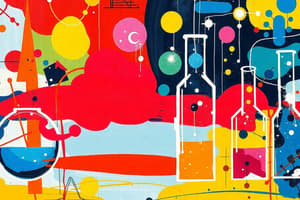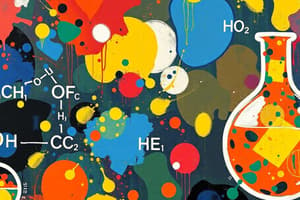Podcast
Questions and Answers
According to the law of conservation of mass, mass cannot be created or destroyed in a chemical ______.
According to the law of conservation of mass, mass cannot be created or destroyed in a chemical ______.
reaction
An equation that gives the same number of each type of atom on both sides is called a ______ equation.
An equation that gives the same number of each type of atom on both sides is called a ______ equation.
balanced
The numbers placed in front of the formulas in a chemical equation are known as ______.
The numbers placed in front of the formulas in a chemical equation are known as ______.
coefficients
When no coefficient is written, it is assumed to be ______.
When no coefficient is written, it is assumed to be ______.
It is easier to balance elements in a chemical equation that appear only ______.
It is easier to balance elements in a chemical equation that appear only ______.
Single replacement reactions involve one element taking the place of another in a ___.
Single replacement reactions involve one element taking the place of another in a ___.
The general form for a double replacement reaction is ___ + DZ → DX + AZ.
The general form for a double replacement reaction is ___ + DZ → DX + AZ.
In combustion reactions, a substance combines with ___ and burns, releasing energy.
In combustion reactions, a substance combines with ___ and burns, releasing energy.
The reaction of 2K + ZnCl2 → 2KCl + Zn is an example of a ___ reaction.
The reaction of 2K + ZnCl2 → 2KCl + Zn is an example of a ___ reaction.
Hydrocarbon combustion typically follows the form CXHY + O2 → CO2 + H2O, where X and Y represent the number of ___ and hydrogen atoms.
Hydrocarbon combustion typically follows the form CXHY + O2 → CO2 + H2O, where X and Y represent the number of ___ and hydrogen atoms.
Flashcards
Balanced Chemical Equation
Balanced Chemical Equation
A chemical equation is balanced when the number of atoms of each element on the reactants' side equals the number of atoms of that element on the products' side.
Coefficients in Chemical Equations
Coefficients in Chemical Equations
Coefficients are numbers placed in front of chemical formulas in a balanced equation. They indicate the relative number of moles of each reactant and product involved in the reaction.
Law of Conservation of Mass
Law of Conservation of Mass
The Law of Conservation of Mass states that in any closed system, the total mass of the reactants before a chemical reaction must equal the total mass of the products after the reaction. No atoms are created or destroyed.
Balancing Chemical Equations
Balancing Chemical Equations
Signup and view all the flashcards
Chemical Reaction
Chemical Reaction
Signup and view all the flashcards
Single Replacement (Metal) Reaction
Single Replacement (Metal) Reaction
Signup and view all the flashcards
Single Replacement (Halogen) Reaction
Single Replacement (Halogen) Reaction
Signup and view all the flashcards
Double Replacement Reaction
Double Replacement Reaction
Signup and view all the flashcards
Combustion Reaction
Combustion Reaction
Signup and view all the flashcards
Decomposition Reaction
Decomposition Reaction
Signup and view all the flashcards
Study Notes
Chemical Reactions
- A chemical reaction is the rearrangement of atoms in one or more substances to form one or more new substances.
- This is represented by a chemical equation.
Reactants and Products
- Reactants are the substances that enter into a chemical reaction.
- Products are the substances that are formed as a result of the reaction.
- Reactions are indicated by the arrow "→" and reactants are listed on the left side of the arrow, while products are listed on the right side of the arrow.
Other Signs of Chemical Reactions
- Gas production
- Light production
- Solid precipitate formation (when two solutions are mixed)
- Temperature change (exothermic or endothermic)
- Color change (permanent)
Diatomic Molecules
- Some elements only exist in nature in diatomic form (two atoms bonded together).
- The diatomic elements are hydrogen (H₂), nitrogen (N₂), oxygen (O₂), fluorine (F₂), chlorine (Cl₂), bromine (Br₂), and iodine (I₂).
- They are always written with a subscript of 2 in a chemical formula, as they cannot exist on their own.
Writing Chemical Equations
- Chemical equations use formulas to describe chemical reactions.
- Formulas show atoms and molecules involved in a reaction.
- Symbols and formulas are needed to represent the reaction accurately; hence the importance of knowing nomenclature rules.
Balancing Chemical Equations
- The law of conservation of mass states that mass cannot be created or destroyed in a chemical reaction.
- The number of atoms of each element must be the same on both sides of the equation.
- Coefficients are used to balance the number of atoms of each element on both sides of the equation.
Types of Chemical Reactions
- Synthesis (two or more substances combine to form a new substance)
- Decomposition (a substance breaks down into two or more substances)
- Single replacement (one element replaces another element in a compound)
- Double replacement (the positive ions (cations) and the negative ions (anions) in two compounds swap places).
- Combustion (a substance reacts rapidly with oxygen, often producing heat and light).
Studying That Suits You
Use AI to generate personalized quizzes and flashcards to suit your learning preferences.




